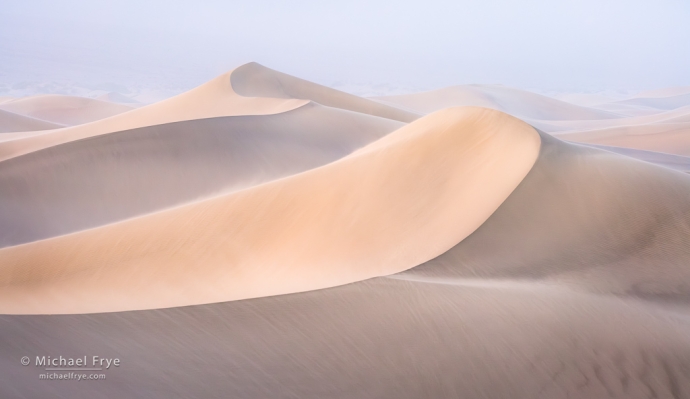
Dunes at sunrise in a sandstorm, Death Valley NP, California. During a dust storm, as you might expect, my sensor accumulated plenty of dust spots (see the next image below).
Removing dust spots from an image can be a tedious chore. Do you want to do that tiresome job twice? I certainly don’t – which is why I remove dust spots in Lightroom, rather than Photoshop.
There’s no way to do retouching in Photoshop in a completely flexible, non-destructive way that adapts to any further changes you make to the underlying layers. But when you remove a spot or object in Lightroom (or Camera Raw), the retouching will always adapt, no matter what you do to the image in the future. Even if you make a drastic change, like lightening the photo by two stops, making a big adjustment to the white balance, or converting it to black and white, the retouching in Lightroom will adapt and blend in seamlessly. And that means you’ll never, ever, have to do it again – which, for me, is a big advantage.
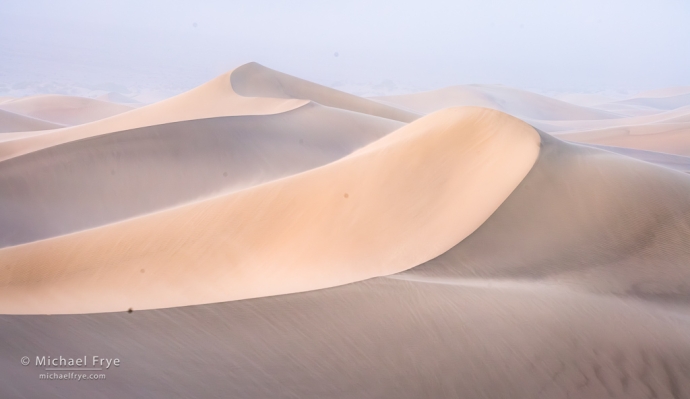
Before retouching this image you can see several dust spots, even zoomed out like this. But I found many more after zooming in, going systematically through the image, and using the Visualize Spots mode.
Removing dust spots in Lightroom can be just as fast as in Photoshop. Maybe even faster, with practice – and with some shortcuts. Here are two simple tips that can speed up spot removal in Lightroom:
Using Page Down to Move Systematically Through the Image

Starting in the upper-left corner of the photo, I hit Page Down (fn+down-arrow on a Mac laptop) to move one screen-width down and systematically search for dust spots.

Here's the next section of the image down from the upper-left corner. I can continue to hit Page Down to scroll through the entire image.
First, when you’re trying to remove dust spots, it helps to move systematically through the image to find all of them. Start by zooming in (I recommend 200% or 2:1 with modern high-res displays). Next, scroll to the upper-left corner. Use the Remove tool to eliminate spots in that upper-left corner, then hit Page Down. That will take you one screen-width down (with a little overlap). Remove all the spots in that area, hit Page Down again, and so on. When you get to the bottom of the first row, hitting Page Down again will take you to the top of the next row to the right. Keep hitting Page Down and removing spots until you get all the way to the bottom-right corner.
Wait, I don’t see a Page Down key on my Mac laptop’s keyboard! No worries: hold down the Function (fn) key on the lower-left corner of the keyboard, then tap the down-arrow key. Holding down that fn key turns the up and down arrows into Page Up and Page Down keys. (Holding down fn also turns the left-arrow key into Home, and the right-arrow key into End. When zoomed in to an image, Home takes you to the upper-left corner, and End takes you to the lower-right corner.)
Visualizing Spots
Some dust spots are hard to see, even when you’re zoomed in and looking closely. Well, they’re hard to see until you hold up your beautiful new 30×40-inch print and notice a spot you missed. Or three spots you missed. Which can lead to using a string of four-letter words.
Fortunately, Lightroom has a “Visualize Spots” function that makes it easier to find those pesky dust spots. Again, I recommend zooming in to 200%. Then, after selecting the Remove tool, click the Visualize Spots checkbox:
Next to the checkbox is a slider to adjust the strength of this feature. The default, with the slider in the middle, is usually fine, but sometimes a stronger setting works better.
Visualize Spots creates a black-and-white overlay that makes faint dust spots jump out clearly – especially in smooth areas like sky and water. Then you can just click on those spots to remove them. (I usually prefer the Remove mode for this, without “Use generative AI” checked. But sometimes the Heal or Clone modes work better.)

Can you see the dust spot in this part of the sky? It’s awfully faint, even with this zoomed-in view – yet spots like this can become glaringly obvious in a print.

Turning on Visualize Spots makes this faint spot much more obvious (and reveals an even fainter spot.)
With textured areas, like rocks or trees, it’s often easier to see dust spots with Visualize Spots turned off. To quickly toggle between the two modes (Visualize Spots on or off), just press the A key. I know keyboard shortcuts can be hard to remember, but this one is worth learning, because if you’re like me you’ll be constantly toggling between the two modes to find those annoyingly hard-to-see dust spots.
Advanced Retouching Webinar
Of course Lightroom can do far more than remove simple dust spots. With the addition of Content-Aware and Generative AI retouching tools, Lightroom can now perform most retouching tasks – even the most complex ones. And, of course, if you do the retouching in Lightroom it’s completely flexible and non-destructive, and you’ll never have to do it again.
In my upcoming Lightroom Webinar: Advanced Retouching, I’ll show you how to stay in Lightroom to perform sophisticated retouching, streamlining your workflow and saving time by never having to repeat these tiresome retouching chores. Here are some of the things you’ll learn:
• Essential tips for using Lightroom’s Remove Tool
• Key shortcuts for making any retouching job faster and easier
• Doing retouching on top of other retouching – the secret to advanced tasks
• Shortcuts for quickly removing linear objects like jet trails and telephone wires
• How to make the most of the sophisticated Content-Aware and Generative-AI tools
Click the link below to learn more or sign up. I hope to see you there!
Lightroom Webinar: Advanced Retouching
$27
The live webinar will take place this Saturday, August 23rd, 2025, at 10:00 a.m. Pacific Time (1:00 p.m. Eastern Time). We expect it to last 90 to 120 minutes. And if you can’t attend live, the webinar will be recorded so you can watch it later.
— Michael Frye
P.S. One more tip: before removing dust spots, clean your computer screen! I can’t tell you how many times I’ve tried to remove a dust spot, only to realize it was a speck of dirt on my monitor.
Related Posts: The Power of Masking; Generative Remove Comes to Lightroom
Michael Frye is a professional photographer specializing in landscapes and nature. He lives near Yosemite National Park in California, but travels extensively to photograph natural landscapes in the American West and throughout the world.
Michael uses light, weather, and design to make photographs that capture the mood of the landscape, and convey the beauty, power, and mystery of nature. His work has received numerous awards, including the North American Nature Photography Association’s 2023 award for Fine Art in Nature Photography. Michael’s photographs have appeared in publications around the world, and he’s the author and/or principal photographer of several books, including Digital Landscape Photography: In the Footsteps of Ansel Adams and the Great Masters, and The Photographer’s Guide to Yosemite.
Michael loves to share his knowledge of photography through articles, books, workshops, online courses, and his blog. He’s taught over 200 workshops focused on landscape photography, night photography, digital image processing, and printing.


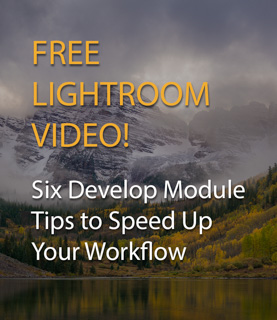





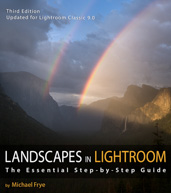
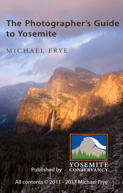
Hi Michael. I find it easier to visualize dust spots if I use the dehaze slider and sometimes the contrast and exposure sliders as well. This means that if doing this in Lightroom, you really need to remove dust spots before making those slider adjustments to improve visibility. Then you must reset the sliders after removing the spots. If this isn’t convenient, then it is easier to bounce back and forth between PS and ACR since each time you go back and forth it resets those sliders. I usually create a new layer so that if I forget to reset my Dehaze, Contrast and Exposure sliders I can just delete the layer and do it over again. The rest of my steps are just like yours. I also go back over the image in the same way after enlarging for print to pick up any bad pixels.
Increasing contrast with Dehaze and/or Clarity can definitely help to bring out dust spots. I’m a little hazy on your workflow based on your description, but whatever works for you, and I think for most people it would be easy enough to reset the Dehaze and Clarity sliders after cleaning up the dust spots.
Greetings Michael, I find it easier to move across the screen horizontally, as most of the dust spots I see are in the sky area. To do this, first turn Caps Lock, then move to the upper left corner, (use the home key if it’s available). Using the Page Down arrow will scroll right, Page Up will scroll left. Just remember to turn Caps Lock off when finished, otherwise some of the functions of keyboard shortcuts can change. Not sure if this will work on Macs as I use PCs.
Also new Remove Spots feature in Camera Raw was introduced recently, however I have not had a chance to try it out.
Scott, thanks for the tip about the Caps Lock, and it does work on a Mac. You can still find dust spots in areas other than the sky, so I’d still recommend that people inspect the entire image. The new Remove Spots feature in Camera Raw is, well, a work in progress. It’ll find some dust spots, but not all. While it helps to have some spots removed automatically, you still have to go through and find the rest, or at least make sure it didn’t miss any. I’m sure it’ll get better over time.